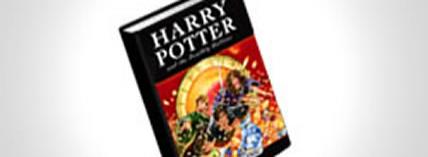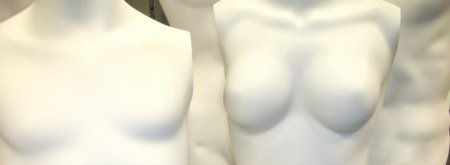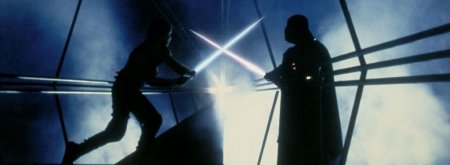Harry Potter and the Deathly Hallows
Ten years after Harry Potter and the Philosopher’s Stone blasted onto the best-seller lists, J.K. Rowling has finally brought the series to a spectacular and moving conclusion with Harry Potter and the Deathly Hallows. It is one of the most satisfying books in the series, though not without its problems.
Rowling has resolved many of the earlier mysteries and tied up many loose ends. Yet at the same time she has wisely refrained from bringing everything to a neat and tidy resolution; there are still mysteries – even some new ones introduced in the seventh book.
Since the confirmation of the final volume’s title, fans have feverishly speculated as to what the ‘Deathly Hallows’ are. I’m not sure whether to feel relieved or disappointed that I didn’t spend long hours poring over the first six books and debating possible clues and theories with other fans online. Looking over some of their speculations now, I’ve seen many extremely well-thought out and accurate guesses about the nature of the horcruxes, but nothing that comes close to the identity of the Deathly Hallows. Given the sheer number of ideas on this in cyberspace, it would be surprising if someone somewhere hasn’t made a lucky guess about some aspect of the Hallows, but it’s largely a new piece of the puzzle that we haven’t been given much inkling of previously.
Warning: this article contains plot spoilers
Although each of the three Hallows plays a vital role within the plot development (one of which we are very familiar with since the first book), we never quite see them brought together to achieve their full power. And it’s a good thing too, because we learn that they would give their bearer immense power: they would make him or her the ‘Master of Death’ (p. 333). The temptation to gain this power had proved too much even for someone as great as Dumbledore. Although Harry spends a considerable proportion of this book feeling resentful that his old headmaster had kept secrets back from him, Dumbledore’s wisdom is proved right once again. Harry needs to know about the Hallows in order to achieve his ultimate goal of destroying Voldemort, but he must not be tempted to put all his effort into acquiring the two which he doesn’t possess. It’s questionable whether or not he would beat the Dark Lord in the race to find one of them – and to lose would make finding and destroying the remaining horcruxes immeasurably more difficult.
Perhaps just as seriously, Harry would find the lure of such immense power impossible to resist. Not only has Dumbledore kept Harry ignorant of their full potential, he magically locks one of them away until such time as Harry must use it, once most of the horcruxes have been destroyed.
It is interesting to compare the three strongest wizards of the series with the tale of the three brothers who first received the gifts from Death. The first brother, ‘who was a combative man, asked for a wand more powerful than any in existence: a wand that must always win duels for its owner, a wand worthy of a wizard who had conquered Death’ (p. 331). Little surprise that this is the Hallow which the violent Voldemort desires so deeply: he is determined to possess a wand that Harry cannot resist. He plans to destroy his nemesis and live for ever. The second brother has interesting echoes of Dumbledore: ‘an arrogant man [who] ... asked for the power to recall others from Death’ (p. 331). It is a surprise to discover that Dumbledore had been an extremely arrogant young wizard, though we know he has some dark secret from the Half Blood Prince. And it seems that a little of that arrogance had stayed with him.
Dumbledore acknowledges how wrong he was to desire the Hallows, describing them as, ‘a desperate man’s dream! ... Real and dangerous, and a lure for fools.... And I was such a fool.... Master of death, Harry, master of Death! Was I better, ultimately, than Voldemort? ... I, too, sought a way to conquer death, Harry’ (p. 571). Harry rightly protests that Dumbledore had not wanted to conquer death in the same way as Voldemort. He had, after all, wanted to right the terrible wrong of his sister’s death by bringing her back from death. Nevertheless, he wanted the power for his own ends, not for the good of others. And he ought to have known that what he wanted was impossible, from the story of the second brother if for no other reason. Rowling insisted years ago that one of her rules for the books was, ‘Magic cannot bring dead people back to life.... there is no returning once you're properly dead.’[1]
‘The youngest brother was the humblest and also the wisest of the brothers, and he did not trust Death. So he asked for something that would enable him to go forth from that place without being followed by Death. And death, most unwillingly, handed over his own Cloak of Invisibility’ (p. 331). There is an obvious connection with Harry, the bearer of the Cloak. Harry does not consider himself to be wise – he has always looked to Dumbledore for wisdom – but, as Jesus said, ‘wisdom is proved right by all her children’ (Luke 7:35). Harry has learnt well from his mentor and now, with extremely limited information and an immense challenge, he chooses the right course of action – not the risky race for the Elder Wand but the annihilation of Voldemort’s soul fragments.
That these three central objects are related to mastery over death is not surprising, given the preoccupation with death throughout the series. Rowling acknowledges that, ‘My books are largely about death. They open with the death of Harry's parents. There is Voldemort's obsession with conquering death and his quest for immortality at any price, the goal of anyone with magic. I so understand why Voldemort wants to conquer death. We're all frightened of it.’[2] Harry lives because of his mother’s self-sacrifice on his behalf – a magic that was beyond Voldemort’s comprehension – and he lives in the shadow of that event; the Dark Lord will stop at nothing to achieve immortality, including murdering people like Cedric in Goblet of Fire; and significant characters die because that’s what happens in war. Rowling’s treatment of death is not callous or morbid: she deals with it as a fact of life, the most unfortunate of all facts, sometimes coming with a growing sense of inevitability and other times coming quickly and unexpectedly. Death can come as a natural end to life or as a deeply unnatural end as a consequence of great evil. It is something that J.K. Rowling has had to come to terms to in her own life, but she still considers that the death of a loved one is her greatest fear.
The most significant death is, of course, Harry’s. Not that he quite dies, as Dumbledore makes clear in their touching meeting almost-but-not-quite beyond the grave:
‘But you’re dead,’ said Harry.
‘Oh, yes,’ said Dumbledore matter-of-factly.
‘Then ... I’m dead too?’
‘Ah,’ said Dumbledore, smiling still more broadly. ‘That is the question, isn’t it? On the whole, dear boy, I think not.’
They looked at each other, the old man still beaming.
‘Not?’ repeated Harry.
‘Not,’ said Dumbledore.
’But ...’ Harry raised his hand instinctively towards the lightning scar. It did not seem to be there. ‘But I should have died – I didn’t defend myself! I meant to let him kill me!’
’And that,’ said Dumbledore, ‘will, I think, have made all the difference.’
Harry’s offering of himself as a sacrifice in order to save others is a profoundly moving moment in the book. It has a particular resonance for Christians because of its potent echo of Jesus Christ willingly giving himself over to forces of evil which wanted to destroy him. In fact, Voldemort only destroyed the horcrux in Harry, but it nevertheless took Harry into some kind of intermediate state (an echo of Neo at Mobil Av station in The Matrix Revolutions) where he was able to choose whether to return to life or to embrace death. His return to life (having apparently suffered no ill effects of his near death experience) can, I think, be seen as some kind of resurrection, or at least a close analogy to it. Until Rowling speaks about this in interviews, it is difficult to be sure whether or not she was deliberately making this connection with Christ’s sacrifice and resurrection (after all, death and resurrection are not unique to Christian faith). Is it simply coincidental that death’s waiting room is King’s Cross? My guess is that Rowling has been more like J.R.R. Tolkien than C.S. Lewis. Tolkien did not set out to write any Christian allegories, yet his Christian worldview shaped much of what he wrote, whereas Lewis was very deliberate in his construction of the allegories in The Chronicles of Narnia. Rowling shares the same Christian worldview, saying that she believes in God and attends church for more than weddings and christenings, though she also says, ‘like Graham Greene, my faith is sometimes about if my faith will return. It's important to me.’ [3]
Whether deliberate or not, Rowling has created an allegory that powerfully illustrates the central truth of the Christian faith (arguably a better one than Lewis’s in some respects). ‘Greater love has no one than this,’ said Jesus, ‘to lay down one's life for one's friends’ (John 15:13, TNIV). This is what Harry knows he must do. He packs away his wand and the invisibility cloak (remember the second brother in the tale finally took off the cloak so that he could greet Death as a friend) and steps forward, surrendering himself to Voldemort’s malevolence. By then returning to life, he has broken Voldemort’s power, not only over himself but over those for whom he died. His ‘resurrection’ encourages and empowers his followers, and enables him to finally destroy the great enemy (in fact, the enemy destroys himself because his power is reflected back at himself).
It is, of course, like all analogies and allegories, imperfect. Harry himself is a very real human character, with faults and failings. He dies to rescue his friends and all good people from a great evil, but he does not die to rescue them from their sin, their rebellion against God, since God is almost entirely absent from the fictional world of Rowling’s imagination. Dumbledore recognises that he was not worthy to bear the three Hallows: ‘I was fit to possess only the meanest of them, the least extraordinary’ (p. 576). Harry also recognises that he cannot become Master of Death, and drops the resurrection stone hoping that it will not be found. But Jesus, in the real, historical world, died and rose again to become Master over death, breaking its power over those who trust him and promising, not a vague, shadowy, temporary return to the world of the living as the resurrection stone brought, but a real, physical and eternal resurrection. Rowling quotes from 1 Corinthians 15:26: ‘The last enemy to be destroyed is death.’ Harry is no longer afraid of death, the Dark Lord and the Death eaters are defeated, but Jesus Christ alone destroys death itself.
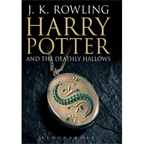 Book title: Harry Potter and the Deathly Hallows (J.K. Rowling)
Book title: Harry Potter and the Deathly Hallows (J.K. Rowling)
Author: J.K. Rowling
Keywords: Death, sacrifice, life, resurrection, salvation, evil
Publisher: Bloomsbury (UK); Arthur A. Levine (USA)
Publication Date: 21 July 2007
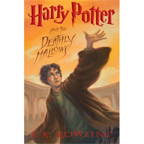
Buy Harry Potter And The Deathly Hallows from Amazon.co.uk
Buy Harry Potter And The Deathly Hallows (USA) from Amazon.com
References
[1] Christopher Lydon, 'J.K. Rowling interview transcript', The Connection (WBUR Radio) 12 October, 1999, quoted at www.accio-quote.org/articles/1999/1099-connectiontransc2.htm
[2] J.K. Rowling, interviewed by Geordie Greig, 'There would be so much to tell her ...', Tatler, 10 January 2006, p.130 (scanned copy at gallery.the-leaky-cauldron.org/picture/2464)
[3] Interview with Geordie Greig, 'There would be so much to tell her ...'
© 2007 Tony Watkins
